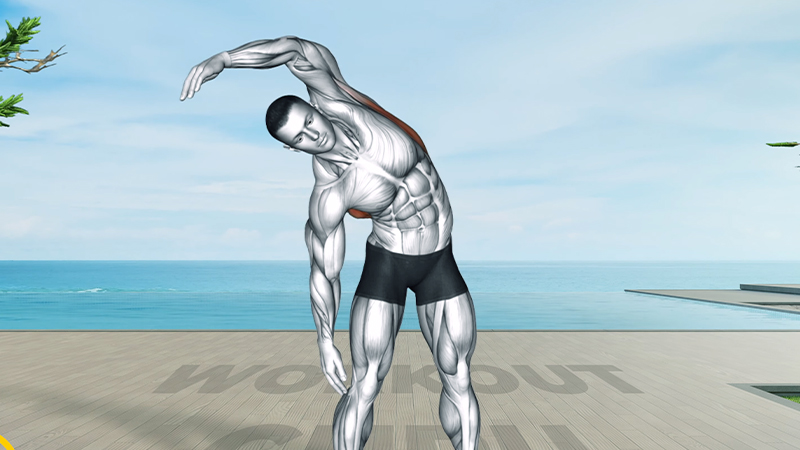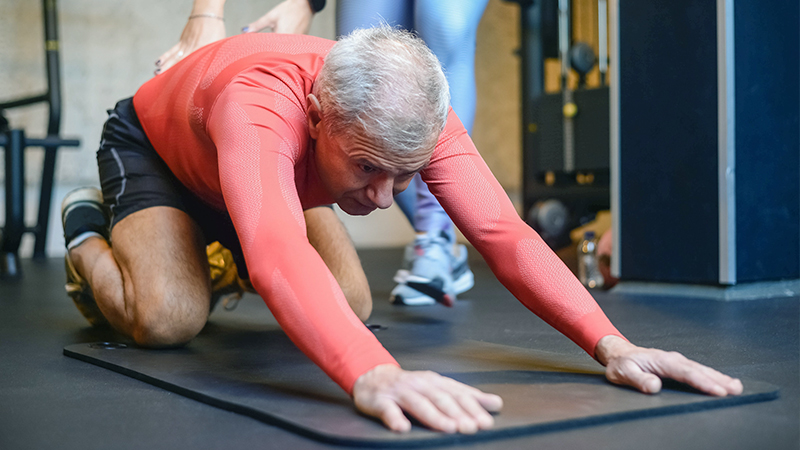Maintaining a strong and stable core is essential for people of all ages, and it becomes even more critical as we grow older. For seniors, core strength is not just about appearance but also about functionality, mobility, and independence.
The core encompasses the muscles in the abdomen, lower back, and pelvis, which play a fundamental role in balance, posture, and overall well-being.
In this article, we delve into the 9 best core exercises for seniors. These exercises are designed to be safe, effective, and adaptable, taking into consideration the unique needs and limitations that come with age.
Whether you’re an active older adult or someone looking to improve their core strength, these exercises offer a path to enhanced stability, better posture, and reduced risk of falls.
9 Best Core Exercises For Seniors
Maintaining core strength is essential for seniors to support balance, stability, and overall functional fitness. Here are 9 core exercises specifically designed for seniors:
1. Seated Knee Extensions

Sit upright in a chair with your feet flat on the floor. Lift one knee towards your chest while keeping your back straight. Alternate legs. This exercise targets the lower abdominal muscles and enhances leg mobility.
2. Seated Torso Twists

Sit with your feet flat on the floor and your hands on your hips. Twist your upper body to one side, then the other. Seated torso twists improve spinal flexibility and strengthen the core.
3. Seated Leg Lifts

Sit at the edge of a chair and extend one leg straight out. Lower it back down and repeat on the other leg. This exercise strengthens the lower abdominal muscles and improves balance.
4. Bridge Pose

Lie on your back with your knees bent, feet flat on the floor, and arms at your sides. Lift your hips off the ground, creating a straight line from your shoulders to your knees. Bridge pose strengthens the lower back, glutes, and core muscles.
5. Planks

Begin in a push-up position but with your weight supported on your forearms. Keep your body in a straight line from head to heels.
Hold the position for as long as it is comfortable. Planks engage the entire core, promoting core stability and strength.
6. Cat-Cow Stretch

Start on your hands and knees with a neutral spine. Inhale, arch your back, and lift your head (cow pose). Exhale, round your back, and tuck your chin (cat pose). The cat-cow stretch enhances spine flexibility and core mobility. This is a very effective exercise.
7. Seated Russian Twists

Sit with your knees bent and your feet flat on the floor. Lean back slightly, lifting your feet off the ground. Twist your torso to one side and then to the other while touching the ground on each side.
Seated Russian twists work the oblique muscles and improve core strength.
8. Leg Raises

Lie on your back with your legs straight. Lift your legs off the ground and then lower them without letting them touch the floor. Leg raises engage the lower abdominal muscles and improve hip flexibility. Be careful with this exercise.
9. Standing side Bends

Stand with your feet shoulder-width apart and your arms extended overhead. Bend your upper body to one side, then the other. Standing side bends work the oblique muscles and enhance core stability.
Incorporating these core exercises into your routine can help improve balance, posture, and overall strength, making daily activities more comfortable and reducing the risk of injury.
Start slowly and gradually increase repetitions or hold times as you build strength.
Always consult with a healthcare provider or fitness professional before beginning any new exercise program to ensure that these exercises are suitable for your individual needs and health status.
What Is The Best Time To Do Some Core Exercises For Seniors?
The best time to do core exercises for seniors can vary based on personal preference, schedule, and overall health. Here are the variations of time to consider:
Morning (Upon Waking Up)
Doing core exercises in the morning helps kickstart metabolism, improves posture throughout the day, and sets a positive tone. It can boost energy levels and promote better mobility, making it an ideal way to start the day.
Mid-Morning
Exercising mid-morning, after the body has had some time to wake up fully, allows for increased flexibility and reduced stiffness. It can enhance mental alertness and create a sense of accomplishment before lunchtime.
Lunchtime
Incorporating core exercises during the lunch break is a great way to break up the day. It provides a mental and physical reset, reducing midday fatigue and stress. Short, focused routines can be done, ensuring productivity for the rest of the day.
Afternoon (Around 3 PM)
Exercising in the late afternoon can combat the post-lunch slump. Core exercises at this time boost circulation, increase energy, and help seniors maintain focus, making it a suitable option for a quick workout.
Early Evening (Before dinner)
Engaging in core exercises in the early evening can relieve tension built up during the day. It can also serve as a transition between work and relaxation, helping seniors unwind and prepare for a peaceful evening.
Dinner Time
While light stretching is suitable during dinner time, intense core workouts immediately after eating should be avoided. Gentle exercises can aid digestion and prevent post-meal lethargy, enhancing overall well-being.
After Dinner (Within an Hour)
Performing core exercises after dinner can be beneficial, provided it’s done gently. It aids digestion and can be a social activity if done with family members.
However, vigorous workouts should be avoided, as they might interfere with sleep.
Evening (Before bedtime)
Engaging in calming core exercises before bedtime can help seniors relax, improve sleep quality, and reduce nighttime restlessness. Gentle stretches and breathing exercises promote relaxation, making it easier to unwind and prepare for sleep.
Anytime When Comfortable
Seniors can perform core exercises at any time when they feel comfortable and motivated. Being consistent is key, so choosing a time that fits into their daily routine and ensures regularity is crucial for reaping the long-term benefits of core exercises.
Regardless of the chosen time, seniors should focus on proper form, breathing, and gradual progression in their core exercises. Consulting a fitness professional or healthcare provider can provide tailored advice based on individual needs and health conditions.
How Often Should Seniors Do Core Exercises?

The frequency of core exercises for seniors should align with their fitness level, goals, and overall health. Here are some different recommendations for how often seniors can engage in core exercises:
Daily
Seniors with well-established core strength and stability may consider doing core exercises daily. These exercises can be relatively brief, focusing on maintaining strength and posture.
Daily routines help build a strong core foundation and enhance balance.
Every Other Day
A core workout every other day allows for ample recovery time. This frequency is suitable for seniors who are looking to build core strength and endurance gradually. It provides a balance between exercise and recovery.
Three Times a Week
For many seniors, aiming to do core exercises three times a week is a manageable and effective approach. These sessions can be more extensive and varied, targeting different aspects of core strength and stability.
Twice a Week
Seniors with busy schedules or who may be new to core exercises can start with two sessions a week. While progress may be slower, consistency is key, and this frequency still allows for noticeable improvements over time.
Once a Week
Even performing core exercises once a week can bring benefits, especially for those who are just beginning or facing time constraints. This frequency is better than not doing any core exercises at all and can contribute to enhanced stability and posture.
Varied Frequency
Seniors can adapt their core exercise frequency based on their energy levels, health, and daily commitments. This flexible approach allows for consistency without rigidity, focusing on quality over quantity.
As Needed
Seniors with specific health concerns or conditions may choose to perform core exercises as needed under the guidance of a healthcare provider or physical therapist. These exercises can be customized to address particular goals or alleviate pain or discomfort.
The key is to find a frequency that aligns with individual capabilities and motivates seniors to maintain their core strength.
Regardless of the chosen frequency, it’s crucial to prioritize proper form and gradual progression, consulting with a fitness professional or healthcare provider for personalized guidance as needed.
FAQs
Why are core exercises important for seniors?
Core exercises are vital for seniors because they enhance stability, improve posture, and reduce the risk of falls. A strong core also supports everyday activities and helps alleviate back pain, making it crucial for maintaining independence and overall well-being.
What are the best core exercises for seniors?
The best core exercises for seniors include gentle options like seated leg lifts, standing side leg raises, and pelvic tilts. More advanced options can include planks, bridges, and seated twists.
Can seniors with back pain benefit from core exercises?
Yes, core exercises can be particularly beneficial for seniors with back pain. Strengthening the core muscles can provide support to the lower back and reduce discomfort.
How often should seniors do core exercises?
Seniors should aim to do core exercises 2-3 times a week to maintain and improve core strength. These exercises can be included as part of a well-rounded fitness routine. The frequency may vary based on individual fitness levels and goals.
Are core exercises safe for seniors with certain health conditions?
Core exercises can be safe for many seniors, but those with specific health conditions should consult with a healthcare provider before starting a new exercise routine. Seniors with conditions like osteoporosis or herniated discs may need to avoid certain exercises or modify them to ensure safety and effectiveness.
Conclusion
The importance of core strength for seniors cannot be overstated. A strong core enhances balance, prevents injuries, and makes everyday tasks more manageable, contributing to a higher quality of life. The best core exercises for seniors provide a practical and sustainable way to achieve these benefits.
Incorporating these exercises into a regular routine not only enhances physical health but also promotes mental well-being. Seniors who prioritize core strength enjoy improved posture, better mobility, and increased independence.
Whether you’re looking to stand tall, walk confidently, or simply maintain an active lifestyle, the best core exercises for seniors offer a holistic path to overall well-being.
It’s crucial to consult with a healthcare provider or fitness professional when starting a new exercise routine, especially if you have underlying health concerns.
This guidance ensures that the chosen exercises are safe and suitable for your individual needs, allowing you to maximize the benefits of improved core strength.
I am a fitness instructor and I have been in the industry for 9 years. I have a passion for health and fitness.
I am a fitness instructor with over 9 years of experience in the industry. My passion is health and fitness and I would love to share my knowledge with you!